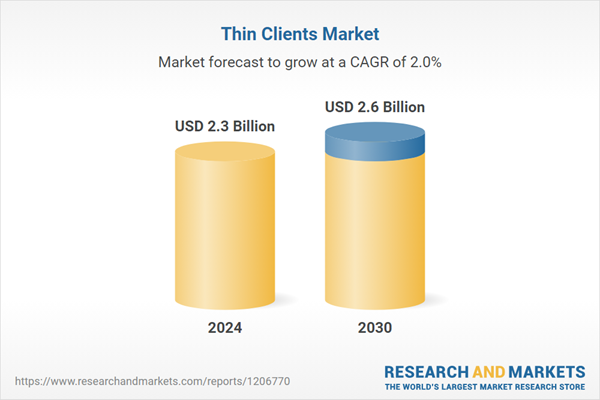The global market for Thin Clients was valued at US$2.3 Billion in 2024 and is projected to reach US$2.6 Billion by 2030, growing at a CAGR of 2.0% from 2024 to 2030. This comprehensive report provides an in-depth analysis of market trends, drivers, and forecasts, helping you make informed business decisions. The report includes the most recent global tariff developments and how they impact the Thin Clients market.
The market for thin clients is influenced by several key trends and technological advancements. One significant trend is the shift towards desktop virtualization, which allows users to access a complete desktop environment from any device with an internet connection. This is particularly beneficial in remote work scenarios, enabling employees to securely access corporate resources from home or other remote locations. Virtual desktop infrastructure (VDI) solutions provided by companies like VMware, Citrix, and Microsoft have become increasingly popular, offering enhanced flexibility and security. Additionally, advancements in network infrastructure, such as faster and more reliable internet connections, have enhanced the performance and user experience of thin clients. With the rise of 5G and fiber-optic internet, latency issues that earlier hampered thin client performance are being mitigated, providing users with seamless and responsive interactions. Security concerns also play a critical role in driving the adoption of thin clients. By limiting local storage and centralizing data management, organizations can implement stricter security policies and quickly deploy updates and patches.
The growth in the thin clients market is driven by several factors. Technological advancements, such as the development of more robust and efficient virtualization software, have made thin clients more capable and versatile. Enhanced features like support for multiple monitors, improved multimedia performance, and integration with various peripherals have expanded the use cases for thin clients. The increasing need for cost-effective IT solutions in various industries has expanded the addressable market for thin clients, as organizations look for ways to reduce hardware and maintenance expenses. Consumer behavior trends, including the rising demand for remote and flexible work options, have further propelled market growth. The expansion of cloud computing services has also played a crucial role, providing the necessary infrastructure to support thin client deployments. Services such as Amazon Web Services (AWS), Microsoft Azure, and Google Cloud Platform offer scalable and reliable environments for hosting virtual desktops and applications. Additionally, the emphasis on cybersecurity and data protection has strengthened the business case for thin clients, as they offer enhanced security through centralized management and reduced local data storage. With growing regulatory requirements and the need to protect sensitive information, thin clients provide a secure and compliant solution for many organizations. Overall, the thin clients market is poised for continued growth, driven by technological innovation, evolving workplace dynamics, and the ongoing shift towards cloud-based IT environments.
Segments: Form Factor (With Monitor, Mobile, Standalone); Application (Enterprise, Government, Education, Industrial).
Geographic Regions/Countries: World; United States; Canada; Japan; China; Europe (France; Germany; Italy; United Kingdom; and Rest of Europe); Asia-Pacific; Rest of World.
The analysts continuously track trade developments worldwide, drawing insights from leading global economists and over 200 industry and policy institutions, including think tanks, trade organizations, and national economic advisory bodies. This intelligence is integrated into forecasting models to provide timely, data-driven analysis of emerging risks and opportunities.
Thin Clients - Key Trends and Drivers
Thin clients are streamlined computing devices designed to rely heavily on a central server for processing power and storage, rather than on their own onboard capabilities. These devices are typically utilized in environments where numerous users need to access shared applications and data, such as in call centers, educational institutions, healthcare facilities, and corporate offices. Unlike traditional PCs, thin clients have minimal hardware and software, which reduces the need for extensive maintenance and support. This simplicity translates to lower costs and easier management, making thin clients an attractive option for organizations seeking to centralize their IT infrastructure. They are known for their efficiency, as they consume less power and have a longer lifespan compared to conventional desktop computers. The advent of cloud computing and virtualization technologies has further propelled the adoption of thin clients, as these devices can efficiently run virtual desktops and applications hosted on remote servers. This capability allows organizations to deliver a consistent and secure user experience across different locations.The market for thin clients is influenced by several key trends and technological advancements. One significant trend is the shift towards desktop virtualization, which allows users to access a complete desktop environment from any device with an internet connection. This is particularly beneficial in remote work scenarios, enabling employees to securely access corporate resources from home or other remote locations. Virtual desktop infrastructure (VDI) solutions provided by companies like VMware, Citrix, and Microsoft have become increasingly popular, offering enhanced flexibility and security. Additionally, advancements in network infrastructure, such as faster and more reliable internet connections, have enhanced the performance and user experience of thin clients. With the rise of 5G and fiber-optic internet, latency issues that earlier hampered thin client performance are being mitigated, providing users with seamless and responsive interactions. Security concerns also play a critical role in driving the adoption of thin clients. By limiting local storage and centralizing data management, organizations can implement stricter security policies and quickly deploy updates and patches.
The growth in the thin clients market is driven by several factors. Technological advancements, such as the development of more robust and efficient virtualization software, have made thin clients more capable and versatile. Enhanced features like support for multiple monitors, improved multimedia performance, and integration with various peripherals have expanded the use cases for thin clients. The increasing need for cost-effective IT solutions in various industries has expanded the addressable market for thin clients, as organizations look for ways to reduce hardware and maintenance expenses. Consumer behavior trends, including the rising demand for remote and flexible work options, have further propelled market growth. The expansion of cloud computing services has also played a crucial role, providing the necessary infrastructure to support thin client deployments. Services such as Amazon Web Services (AWS), Microsoft Azure, and Google Cloud Platform offer scalable and reliable environments for hosting virtual desktops and applications. Additionally, the emphasis on cybersecurity and data protection has strengthened the business case for thin clients, as they offer enhanced security through centralized management and reduced local data storage. With growing regulatory requirements and the need to protect sensitive information, thin clients provide a secure and compliant solution for many organizations. Overall, the thin clients market is poised for continued growth, driven by technological innovation, evolving workplace dynamics, and the ongoing shift towards cloud-based IT environments.
Report Scope
The report analyzes the Thin Clients market, presented in terms of units. The analysis covers the key segments and geographic regions outlined below.Segments: Form Factor (With Monitor, Mobile, Standalone); Application (Enterprise, Government, Education, Industrial).
Geographic Regions/Countries: World; United States; Canada; Japan; China; Europe (France; Germany; Italy; United Kingdom; and Rest of Europe); Asia-Pacific; Rest of World.
Key Insights:
- Market Growth: Understand the significant growth trajectory of the With Monitor segment, which is expected to reach US$1.2 Billion by 2030 with a CAGR of a 1.7%. The Mobile segment is also set to grow at 1.9% CAGR over the analysis period.
- Regional Analysis: Gain insights into the U.S. market, valued at $623.8 Million in 2024, and China, forecasted to grow at an impressive 1.7% CAGR to reach $411.8 Million by 2030. Discover growth trends in other key regions, including Japan, Canada, Germany, and the Asia-Pacific.
Why You Should Buy This Report:
- Detailed Market Analysis: Access a thorough analysis of the Global Thin Clients Market, covering all major geographic regions and market segments.
- Competitive Insights: Get an overview of the competitive landscape, including the market presence of major players across different geographies.
- Future Trends and Drivers: Understand the key trends and drivers shaping the future of the Global Thin Clients Market.
- Actionable Insights: Benefit from actionable insights that can help you identify new revenue opportunities and make strategic business decisions.
Key Questions Answered:
- How is the Global Thin Clients Market expected to evolve by 2030?
- What are the main drivers and restraints affecting the market?
- Which market segments will grow the most over the forecast period?
- How will market shares for different regions and segments change by 2030?
- Who are the leading players in the market, and what are their prospects?
Report Features:
- Comprehensive Market Data: Independent analysis of annual sales and market forecasts in US$ Million from 2024 to 2030.
- In-Depth Regional Analysis: Detailed insights into key markets, including the U.S., China, Japan, Canada, Europe, Asia-Pacific, Latin America, Middle East, and Africa.
- Company Profiles: Coverage of players such as 10ZiG Technology Inc., Advantech Co., Ltd., ASUSTeK Computer, Inc., Centerm Information Co., Ltd., Cisco Systems, Inc. and more.
- Complimentary Updates: Receive free report updates for one year to keep you informed of the latest market developments.
Some of the 12 companies featured in this Thin Clients market report include:
- 10ZiG Technology Inc.
- Advantech Co., Ltd.
- ASUSTeK Computer, Inc.
- Centerm Information Co., Ltd.
- Cisco Systems, Inc.
- Dell Technologies, Inc.
- Fujitsu Ltd.
- Hewlett-Packard Development Company LP
- IGEL Technology GmbH
- Lenovo Group Ltd.
- LG Electronics, Inc.
- NComputing
- NEC Corporation
- Samsung Electro-Mechanics
- Siemens AG
Tariff Impact Analysis: Key Insights for 2025
Global tariff negotiations across 180+ countries are reshaping supply chains, costs, and competitiveness. This report reflects the latest developments as of April 2025 and incorporates forward-looking insights into the market outlook.The analysts continuously track trade developments worldwide, drawing insights from leading global economists and over 200 industry and policy institutions, including think tanks, trade organizations, and national economic advisory bodies. This intelligence is integrated into forecasting models to provide timely, data-driven analysis of emerging risks and opportunities.
What’s Included in This Edition:
- Tariff-adjusted market forecasts by region and segment
- Analysis of cost and supply chain implications by sourcing and trade exposure
- Strategic insights into geographic shifts
Buyers receive a free July 2025 update with:
- Finalized tariff impacts and new trade agreement effects
- Updated projections reflecting global sourcing and cost shifts
- Expanded country-specific coverage across the industry
Table of Contents
I. METHODOLOGYII. EXECUTIVE SUMMARY2. FOCUS ON SELECT PLAYERSIII. MARKET ANALYSISIV. COMPETITION
1. MARKET OVERVIEW
3. MARKET TRENDS & DRIVERS
4. GLOBAL MARKET PERSPECTIVE
UNITED STATES
CANADA
JAPAN
CHINA
EUROPE
FRANCE
GERMANY
ITALY
UNITED KINGDOM
REST OF EUROPE
ASIA-PACIFIC
REST OF WORLD
Companies Mentioned (Partial List)
A selection of companies mentioned in this report includes, but is not limited to:
- 10ZiG Technology Inc.
- Advantech Co., Ltd.
- ASUSTeK Computer, Inc.
- Centerm Information Co., Ltd.
- Cisco Systems, Inc.
- Dell Technologies, Inc.
- Fujitsu Ltd.
- Hewlett-Packard Development Company LP
- IGEL Technology GmbH
- Lenovo Group Ltd.
- LG Electronics, Inc.
- NComputing
- NEC Corporation
- Samsung Electro-Mechanics
- Siemens AG
Table Information
| Report Attribute | Details |
|---|---|
| No. of Pages | 268 |
| Published | April 2025 |
| Forecast Period | 2024 - 2030 |
| Estimated Market Value ( USD | $ 2.3 Billion |
| Forecasted Market Value ( USD | $ 2.6 Billion |
| Compound Annual Growth Rate | 2.0% |
| Regions Covered | Global |









